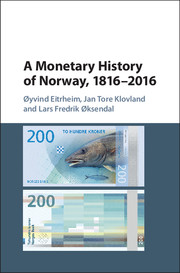Book contents
- Frontmatter
- Contents
- List of Figures
- List of Tables
- Preface
- 1 A Monetary History in Five Parts
- PART I THE LONG PROMISE, 1816–1850
- PART II THE RISE OF PRIVATE DEPOSIT-TAKING BANKS, 1850–1914
- PART III WORLDWAR I AND TURBULENT INTERWAR YEARS, 1914–1940
- PART IV MONEY IN TIMES OFWAR, CENTRAL PLANNING AND REGULATION, 1940–1986
- 10 The Extreme Liquidity Creation during the Occupation Years, 1940–1945
- 11 Money in a NewWorld, 1945–1955
- 12 The Era of Corporative Policy and Regulation, 1955–1971
- 13 From Regulation to Markets in an Embryonic Oil Economy, 1971–1986
- PART V THE LONG RETURN, 1986–2016
- Bibliography
- Index
11 - Money in a NewWorld, 1945–1955
from PART IV - MONEY IN TIMES OFWAR, CENTRAL PLANNING AND REGULATION, 1940–1986
Published online by Cambridge University Press: 09 February 2017
- Frontmatter
- Contents
- List of Figures
- List of Tables
- Preface
- 1 A Monetary History in Five Parts
- PART I THE LONG PROMISE, 1816–1850
- PART II THE RISE OF PRIVATE DEPOSIT-TAKING BANKS, 1850–1914
- PART III WORLDWAR I AND TURBULENT INTERWAR YEARS, 1914–1940
- PART IV MONEY IN TIMES OFWAR, CENTRAL PLANNING AND REGULATION, 1940–1986
- 10 The Extreme Liquidity Creation during the Occupation Years, 1940–1945
- 11 Money in a NewWorld, 1945–1955
- 12 The Era of Corporative Policy and Regulation, 1955–1971
- 13 From Regulation to Markets in an Embryonic Oil Economy, 1971–1986
- PART V THE LONG RETURN, 1986–2016
- Bibliography
- Index
Summary
Introduction
Monetary development in the years after 1945 necessarily reflected the financial and economic challenges created by war. The monetary overhang still loomed over the country and there was an urgent need for restoring broken trading links and production capacity. In a sense, the challenges arising from the war, although substantial, were all short term in nature. Subsequent development showed that they were fairly soon overcome. Already by 1947, output in per capita terms had surpassed 1939. By 1950, the export volume had regained the prewar level. At the beginning of the new decade, the monetary overhang had been more or less eliminated.
Arguably, more important than the war for understanding money in the postwar period are the long-term challenges derived from the interwar period. In 1920, statesmen and economists alike had believed they could look back to the golden years before 1914 when planning for peace. In 1945, few held any notion of a prewar idyll. The legacy of the interwar period was one of de-globalisation, high unemployment, sluggish growth and instability. Thus, for those who assumed the role of architects for a postwar future, the past gave guidance only in the negative, as the very antithesis of what they strived to achieve. A return to the world of the 1930s would have implied – at least with regard to how the economy was organized – that the war had been for nought.
In the same manner that the interwar debacle provided the fundamental challenges facing the postwar planners, the answers found originated in the same period. The 1920s and 1930s had been decades of great uncertainty. Truths that once had been commonly accepted were questioned. The search for new answers took place along a broad front not least in economic thinking and policymaking. Economic liberalism was in decline and the trust in markets at low ebb. In their place, the insights derived from Keynes and the lure of planning for many gave hope for a better future. With the new thinking followed enhanced ambitions for the role of governments in the economy and a strong belief in the ability of economic policy and economists to achieve desired ends.
- Type
- Chapter
- Information
- A Monetary History of Norway, 1816–2016 , pp. 408 - 443Publisher: Cambridge University PressPrint publication year: 2016

